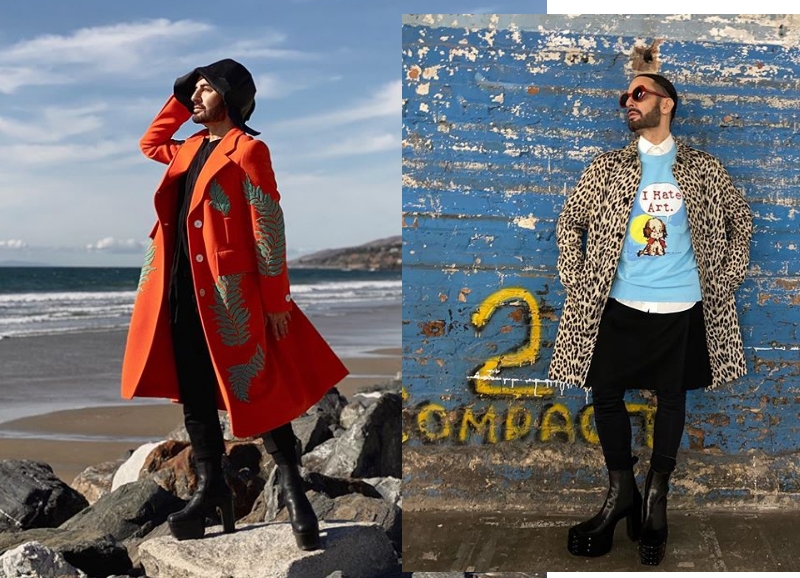Have we finally embraced men in high heels? Sales have been on the upturn since 2017 and searches for “men’s heels” have grown by 30%, according to Lyst.co.uk.
Perhaps unexpectedly, the stiletto heel is being used to articulate what it means to be a man in the post-#MeToo era. In October, Strictly Come Dancing’s Johannes Radebe memorably wore stiletto heels for a choreographed tribute to New York’s Ballroom scene, with Twitter users praising him for “shutting down toxic masculinity across the UK in 2 minutes”.
And earlier last year, the singer Sam Smith posted a photo of a heeled boot with the caption: “Tonight I wore heels for the first time to an award show … There was a time when I thought I’d never ever ever be able to be myself like this in front of the industry or anyone.”

The fashion designer Marc Jacobs has spent much of this year posting selfies in massive heeled boots too. “I think there is something incredibly refreshing about a male designer such as Marc Jacobs embracing wearing high heels,” said Andrew Groves, a professor of fashion design at the University of Westminster. “High heels have become a potent symbol of both power and status, and paradoxically both dominance and submission.” Indeed the stiletto heel on a man is still an image that provokes outrage; earlier this month a nude portrait of the Mexican revolutionary Emiliano Zapata wearing nothing but heels and a pink sombrero caused outrage in Mexico, with a spokesperson for protesters calling it “disgusting”.
The growth of the male heel has expanded beyond the stiletto, as different types of heeled shoe have been embraced by fashion, with Gucci, Maison Margiela and Saint Laurent showcasing the Chelsea, Jacquard and split toe boots as well as heeled loafers. Male celebrities such as Shawn Mendes, Harry Styles and Timothée Chalamet have all experimented with a stack heeled shoe on the red carpet, taking cues from glam rock icons such as the New York Dolls, Kiss and David Bowie. The designer Laurence Dacade said the high boots she makes changes the gait of her customers so “they feel more powerful and sexy”, adding that her biggest seller is “a David Bowie [inspired] bootie with a 6cm heel”.

The gender-blurring 70s are a significant reference point for designers this season, “particularly in the way that masculinity was performed as something which could be both outlandish, decorative and still highly potent”, said Ellen Sampson, the author of the forthcoming book Worn: Footwear, Attachment and Affects of Wear. “The 1970s saw a 1930s/40s revival which spurred interest in 1940s shoe shapes, particularly Ferragamo-style platforms, which recently inspired the Gucci platform” .
A blurring of time, gender, race and shoe politics was also visible in last year’s “yeehaw agenda” – a black-consciousness-led update of the cowboy look – which GQ called “the biggest fashion trend to emerge from the internet this year”. Yeehaw’s heeled cowboy boot silhouette has been embraced by designers such as Amiri, Haider Ackermann and Céline and worn by the likes of Lil Nas X, Diplo and Post Malone. “Cowboy boots have become a firm favourite among style influencers and it’s not a surprise we’ve seen an uplift in searches for them on eBay this year,” said Helen Riley, the fashion acquisition manager at eBay UK, which has had a 32% increase in searches since October. “I imagine this is a trend that will continue into the new year.” The impact of the Yeehaw has slyly undermined the ethos of the current US administration. “In Trump’s America, the cowboy is such a symbolic representation of American ideals of masculinity that it has become ripe to be appropriated and subverted,” said Groves.
Paradoxically, this year also exposed women’s complicated relationship to the heel. Female workers in Japan battled against an edict of the compulsory wearing of heels at work and in August Women’s Wear Daily published a piece asking “have sneakers made stilettos irrelevant?”
guardian.co.uk © Guardian News & Media Limited 2010
Published via the Guardian News Feed plugin for WordPress.


